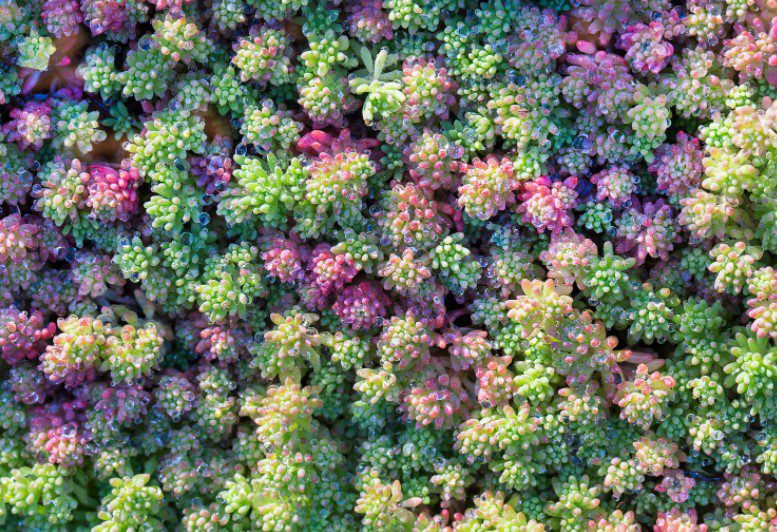Planting Sedum
There are very few plants more forgiving of sun and bad soil than sedum plants. The Magic of Groundcover Underneath perennials, or in the absence of grass, it is perfect to fill in a space with a low-growing groundcover.
My first introduction to the impact of groundcover in a garden was in my mom’s front yard garden growing up. ‘Dragon’s Blood’ stonecrop spread with controlled abandon underneath a pea shrub and around the perennials below.
It cascaded over a decorative rock, and the bees absolutely loved it! The spreader also provided year-round interest. In my current home, I have a chartreuse variety of sedum with yellow flowers in my gardens when I moved in.
It likes to pop up unannounced throughout my gardens, but I don’t mind. It is extremely drought tolerant and adds welcome hits of color.
Groundcovers are a great way to fill in space around a tree to add another layer in front of a grouping of plants of various heights. They can also be used as a solution to fill in gaps between pathways.
Depending on which varieties you choose, they can look nice through all the seasons. Another bonus? They cover the space that weeds might otherwise occupy (though do keep an eye out for the more pernicious ones that like to sneak in when you aren’t looking).
And going back to the grass discussion, groundcover can also take the place of grass. For areas that get a bit of traffic—perhaps you have a few stepping stones peppered throughout your front yard garden—look for walkable or treadable groundcovers, such as
Irish moss or woolly thyme. It’s worth noting that some walkable groundcover plants may be labeled “treadable,” but they are sensitive to constant foot traffic. Check the plant tag to confirm.
Groundcover can also be used to great effect on a natural driveway. Of course, if your car leaks any type of fluid, it won’t be good for the plants, but otherwise, a strip of mixed ground cover between the areas where the two tires sit can look quite stunning.
Plant A Sedum Carpet
As some gardeners work to turn their lawns into gardens, others have transformed their driveways into a garden—but one in which cars can still park.
This is a novel idea, but it adds a whole new visual appeal in place of ordinary asphalt or a concrete driveway. Groundcover plants need to be chosen according to a low maximum height.
I’ve seen moss, creeping thyme, different varieties of sedum, and more used to fill a driveway garden—which is why, when I approached friends about turning a small strip of their front yard into a driveway garden, the first thing I thought about using was sedum mats.
With parking at a premium on a one-way street, this urban semidetached house has the space for two cars between the house and the sidewalk. As such, there is no front lawn. Most of the driveway is asphalt but a small section of (removable) patio stones.
The perfect place for a carpet of colorful sedum. And the placement was such that a second car could fit nicely over the top, with the driveway garden fitting well within the wheels of a car.
I first encountered sedum mats as a suggested option for green roof plans. Sedums are drought and heat tolerant, provide winter interest, and can survive in poorer soil.
Another bonus? Sedums attract butterflies, bumblebees, and hummingbirds. They are also lower maintenance than a lawn in the long run.
Why not use them on a driveway? Some sedum mats are rolled up like sod, but mine came in tiles because of the smaller space I was covering. They were straightforward to install, and the finished result looked like one long continuous, interesting, multi-colored carpet.
Some of the sedums had even started to bloom, so this little island of vegetation was ready to attract pollinators. Furthermore, it looks so gorgeous; the homeowners are now loathe to allow a visiting car to use the spot.
Minimum sun exposure is three to four hours per day. Also, noting that it is a bit of a walkway, sedum mats will suffer through the odd step but are not meant for constant treading.
I was filling a small space, but I recommend that you consult a professional to help assess the grade and runoff management if you’re tearing up an entire driveway.
Installing a Sedum Mat Carpet
Sedum mats need 3 to 4″ (7.6 to 10.2 cm) of growing space beneath them. It was recommended that I create a base of 3 to 4″ (7.6 to 10.2 cm) of green-roof growing medium, which is a special blend that allows for drainage.
Because there was grit beneath the patio stones, I added regular garden soil overtop instead, as recommended by a local nursery that happens to sell the sedum mats.
Use a rake to spread the soil evenly throughout the entire area.
1. Lay out each sedum mat “tile” so it fits snug against either the sides of whatever your border is or the mat beside it.
2. Use the soil knife to trim any pieces that don’t fit into the space. Turn the tile, so the outer edge isn’t the trimmed one. The inner trimmed edge will fit seamlessly against the other tile, whereas the outer edge will retain that wild, natural look that spills over the edges a bit.
3. Give your sedum mats a good daily watering until the plants become established.



























